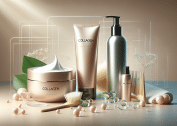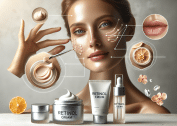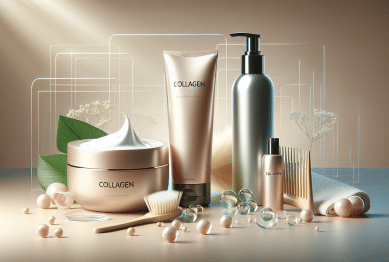Curious about why your skincare routine may stall? Discover the science and strategies behind skin barrier repair, including how ceramides, hydration, and peptides work together for visible, lasting wellness. Find out how smart ingredients protect, soothe, and renew your skin from the inside out.
The Skin Barrier Unveiled
The skin barrier does more than just separate you from the outside world. This critical layer, also known as the stratum corneum, shields your body against pollutants, toxins, and pathogens. It locks in moisture and keeps harmful elements out. When it’s intact, your skin looks radiant, feels soft, and responds better to nutrient-rich products. But what exactly determines the health of this invisible guard? A healthy balance of lipids, primarily ceramides and fatty acids, creates a flexible yet protective structure. This layer defends against dryness, redness, and sensitivity by preserving the underlying layers from environmental stress.
Much of the skin barrier’s strength comes from tiny molecules called ceramides. They act like glue—holding skin cells together—so water can’t escape easily and aggressors can’t get in. People with impaired barriers often notice dullness, flaking, or persistent irritation. Intriguingly, genetics, climate, harsh cleansers, and overuse of actives can all diminish barrier function. As scientific understanding has grown, leading dermatologists now focus as much on repairing and maintaining the barrier as on treating surface imperfections. New research continues to reveal why this external shield is so vital for long-term skin wellness (Source: https://www.aad.org/public/everyday-care/skin-care-basics/care/skin-barrier).
Recognizing early signs of barrier weakness—such as excessive dryness after cleansing or stinging from common products—can help avoid further harm. People sometimes overlook this step, thinking tightness or peeling means a product is ‘working.’ However, these are often warnings that the outermost layer is suffering. Unlocking the secret to long-term skin health might mean prioritizing barrier protection and repair. Whether through conscious ingredient choices or gentle skincare habits, reinforcing your natural shield leads to visible improvements over time.
Signs Your Skin Barrier Needs Help
Could the discomfort you feel after washing your face be a red flag? When the skin barrier is disrupted, moisture loss and inflammation quickly follow. Tightness, flaking, and rough texture are typical warning signs. Sometimes the skin flushes or stings, especially after applying everyday moisturizers or serums. Increased sensitivity suddenly appears, making old favorites seem harsh. Eventually, makeup may not sit as smoothly, and flare-ups seem more stubborn or frequent. Simply, the skin starts to ‘ask’ for gentler care and extra protection.
Dermatologists explain that a damaged skin barrier can open the door to chronic conditions like eczema, redness, or unpredictable outbreaks. Even small disruptions create microscopic cracks. Bacteria and allergens may slip inside, sparking inflammation. Many professionals now recommend monitoring your skin’s reaction to weather shifts, hormonal changes, or new products. A surprising number of people ignore these signals, chasing aggressive treatments instead of support strategies. Learning to notice and decode your skin’s unique cues is central to effective, age-defying skincare (Source: https://www.ncbi.nlm.nih.gov/pmc/articles/PMC8702336/).
Lifestyle choices also play a huge role: frequent hot showers, strong soaps, exfoliants, and inconsistent routines can worsen issues. If artificial fragrances, environmental pollution, or UV exposure are daily realities, the barrier works even harder. Recognizing and addressing these triggers is step one. Many people discover that repairing their barrier allows their skin to better tolerate active ingredients and achieve a luminous, even-toned complexion. Healthier skin responds faster and shows visible glow in less time.
Science-Backed Ingredients for Barrier Repair
Powerful ingredients can reinforce the skin’s natural defenses. Ceramides top the list; they’re essential lipids found naturally in your skin that boost resilience and lock in hydration. When used in creams or serums, they help fill gaps in the barrier and create an invisible seal. Another hero, hyaluronic acid, acts like a moisture magnet—pulling water into the upper layers. This keeps skin plump, bouncy, and resistant to environmental challenges like wind or dry air. Niacinamide has also gained scientific favor for calming redness and supporting the creation of stronger cellular walls (Source: https://www.healthline.com/health/skin-barrier).
Fatty acids and cholesterol are equally important. These natural oils can be found in certain plant-based skincare, like squalane or sunflower oil, and reinforce the skin’s ability to retain water. Recent studies suggest that products containing balanced ratios of ceramides, fatty acids, and cholesterol can accelerate the recovery of a damaged barrier. Look for formulas that deliver soothing botanicals, such as colloidal oatmeal or centella asiatica, which reduce discomfort and promote harmony. The right blend, backed by science, is remarkably effective in restoring softness and clarity.
Don’t forget peptides—a trending ingredient that signals new cell growth and repair. Peptides work alongside antioxidants, like vitamin E, to shield skin from damaging free radicals and future assaults. Fragrance-free, oil-based cleansers and gentle hydrating masks have become staples for anyone seeking to mend or fortify their barrier. Incorporating these smart ingredients consistently can transform reactive or dull skin into one that feels more comfortable, looks dewy, and resists age-accelerating stressors.
Daily Habits That Support and Heal
Repair isn’t just about products. Habits matter—sometimes more than anything in your serum collection. Avoiding harsh scrubs and switching to pH-balanced, non-stripping cleansers sets the stage for recovery. Try warm (not hot) water and pat skin dry gently. After cleansing, layer on moisture within a minute to seal in hydration. These simple adjustments may seem trivial, but over days and weeks, they quietly repair much of the damage done by environmental and chemical stress.
Healthy skin also thrives on a predictable routine. Limit exfoliation—maybe once a week, if at all, while healing. Choose a broad-spectrum sunscreen, even on cloudy days, to defend against invisible UV damage. Many experts now recommend avoiding actives like retinoids or acids until your barrier feels strong. Instead, look for fortifying ingredients and routines focused on nourishment. Each time you resist the urge to ‘overdo,’ you give the barrier a chance to rebuild and perform better long-term. Consistency outshines complexity when it comes to wellness and beauty (Source: https://www.mountsinai.org/health-library/selfcare/skin-care).
Dehydration can impact the skin from the inside, too. Hydrating with water, eating foods rich in omega-3 fatty acids, and getting quality sleep all strengthen your skin’s natural defenses. Mindful habits, like reducing stress and using a humidifier in dry environments, provide extra support. Over time, these small daily acts yield visible changes: increased comfort, less redness, and a surface that glows with health—naturally and sustainably.
Unlocking Advanced Therapies and Trends
Some turn to advanced therapies for stubborn or recurring issues. Dermatologists may suggest prescription creams packed with medical-grade ceramides, barrier-boosting peptides, or gentle anti-inflammatory compounds. Phototherapy and microneedling, when performed by professionals, can help trigger deeper regeneration by encouraging the production of fresh, strong skin cells. These therapies go beyond home care, offering tailored solutions for those who struggle with flare-ups that don’t respond to OTC products alone (Source: https://www.dermnetnz.org/topics/the-skin-barrier).
Technology is bringing new hope to sensitive or desperate skin. Microbiome-friendly skincare—products designed to encourage the ‘good’ bacteria on your skin—are trending worldwide. By restoring microbial diversity, these formulas work with, not against, your body’s natural systems. The latest barrier creams and balms work as invisible shields, blocking pollutants and chemical irritants without heavy residue. Staying updated with innovations can empower you to make choices based on research, not just marketing.
Still, the gold standard is a customized plan. Experts recommend consulting a dermatologist for persistent symptoms or if you suspect a medical condition is affecting your barrier (like rosacea or psoriasis). Professional diagnosis ensures that you get targeted solutions matched to your unique biology and environment. Many clinics now combine scientific testing with soothing, non-invasive treatments, so sustainable repair is within reach for people of every age and skin type.
Prevention and Long-Term Glow
Once your skin barrier is restored, ongoing care is all about prevention. Listening to your skin’s needs as the seasons, diet, or lifestyle changes can help maintain resiliency. Rotate lighter lotions in summer and richer creams in winter. Stick with mild, fragrance-free formulas to avoid unintentional setbacks. Awareness of common triggers—from overcleansing to excessive air conditioning—will keep setbacks to a minimum.
Protective measures continue to evolve. UV-protective clothing, advanced sunscreens, and even smart facial mists that lock in moisture are now accessible. Layering antioxidant serums under sunscreen creates a double barrier against pollutants and oxidation. Customized nutraceuticals, like those with vitamin D or probiotics, have also been explored as adjuncts for skin wellness. Healthy choices build up over time, delivering resilience and radiance that can withstand everyday challenges.
The secret to a beautiful glow is simple: respect the skin’s incredible intelligence. Trust the process of repair, support with proven choices, and treat yourself to gentle rituals. The rewards—comfort, confidence, youthful bounce—reflect the harmony beneath the surface. Skin that feels good looks great, inside and out.
References
1. American Academy of Dermatology Association. (n.d.). Skin care basics: How to strengthen your skin’s barrier. Retrieved from https://www.aad.org/public/everyday-care/skin-care-basics/care/skin-barrier
2. Diona Damian, MD, et al. (2022). Stratum corneum, skin barrier and the role of ceramides. Retrieved from https://www.ncbi.nlm.nih.gov/pmc/articles/PMC8702336/
3. Healthline Media. (n.d.). What is the skin barrier, and how do you protect it? Retrieved from https://www.healthline.com/health/skin-barrier
4. Mount Sinai Health System. (n.d.). Skin care. Retrieved from https://www.mountsinai.org/health-library/selfcare/skin-care
5. DermNet New Zealand. (n.d.). The skin barrier. Retrieved from https://www.dermnetnz.org/topics/the-skin-barrier
6. Williams, L. R. et al. (2019). Repair and restoration of the skin barrier. Australian Skin Health Institute. Retrieved from https://www.skinhealthinstitute.org.au/page/lock-it-in—skin-barrier-repair









